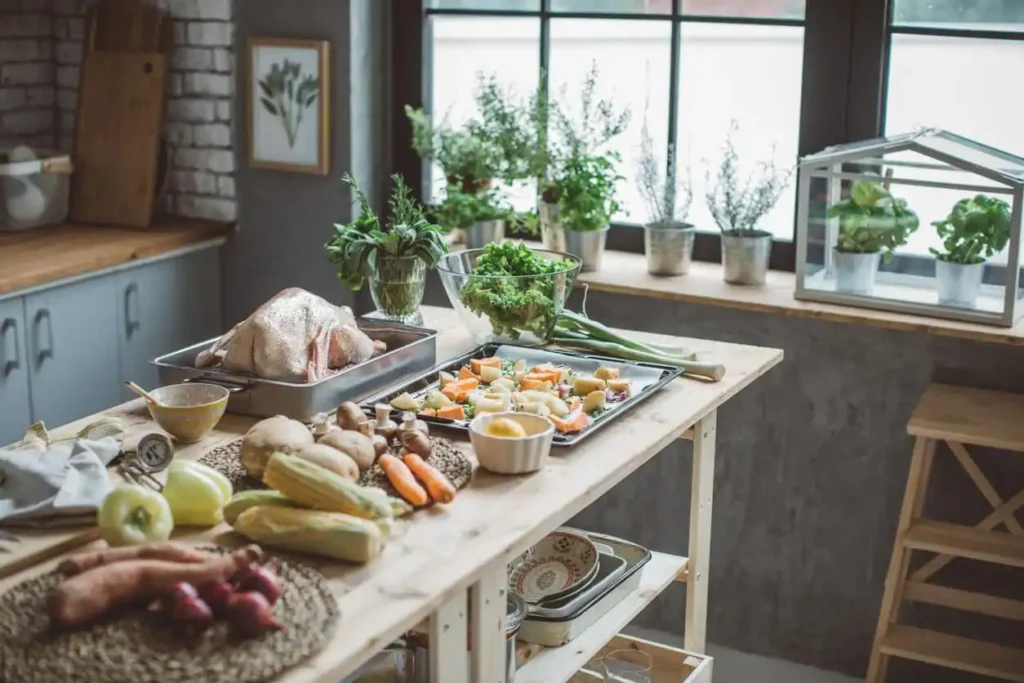
Before we dive into the how, let’s talk about the why — because motivation is what’ll keep your garden alive on those “ugh I forgot to water it” days.
Healthier Food, Zero Chemicals
You know exactly what’s going into your food — because you’re the farmer now. No pesticides, no preservatives, no secrets.Therapy That Grows You Food
Gardening isn’t just good for your stomach — it’s great for your soul. It lowers stress, boosts mood, and gives you something to nurture (other than your houseplants you keep accidentally ghosting).Better for the Planet
Home gardening reduces carbon miles, food packaging waste, and promotes sustainable living. Small space, big impact.Educational and Empowering
As a trainer, I’ve seen how kitchen gardens spark curiosity in kids, adults, and even skeptical grandparents. It reconnects us with the source of our food — something we lost in the age of supermarkets.
Step-by-Step: How to Start Your Organic Kitchen Garden
Alright, gloves on (or not, if you’re into messy hands). Here’s your step-by-step guide to building your very own edible paradise.
1. Choose Your Spot
Whether it’s a balcony, terrace, backyard, or windowsill — light is key. Most veggies and herbs need 4–6 hours of sunlight daily.
My pro tip from field practice: Morning sunlight is softer and ideal. Avoid harsh afternoon sun unless your plants are really into sunbathing.
2. Start Small, Stay Sane
Don’t try to grow everything at once — you’re not starting a farm (yet). Start with 3–4 easy-to-grow plants:
Mint – Grows like gossip in a small town.
Tomatoes – Reliable and rewarding.
Coriander – A must for every Indian kitchen.
Chili or Spinach – Fast-growing and satisfying.
Once you gain confidence, you can expand your leafy empire.
3. Choose the Right Containers
Use pots, grow bags, buckets, wooden crates, or even old paint tins (cleaned, please). Just make sure they have:
Drainage holes
A depth of 6–12 inches depending on the plant
From my training sessions: I always tell students — “Plants don’t care about aesthetics, they care about airflow and drainage.” So don’t overspend on fancy pots unless you want to.
4. Get the Soil Right (It’s Everything)
A good potting mix is 40% garden soil + 30% compost + 30% cocopeat or sand (for drainage).
Use vermicompost or homemade kitchen compost if you can — it’s the best thing you can feed your plants.
From field observations and student projects, I’ve seen this mix work wonders for beginners — especially when soil quality is unpredictable in urban settings.
5. Sow with Care
You can start with seeds or seedlings (nursery-bought). While sowing:
Don’t bury seeds too deep. A general rule: plant at a depth twice their size.
Water lightly after sowing to keep the soil moist (not soggy).
Be patient — seeds have their own sense of timing, much like toddlers.
6. Water Wisely
Overwatering is the top cause of plant drama. Water early in the morning or late evening — when it’s cooler.
My tip for first-timers: Stick your finger in the soil. If the top 1 inch is dry, it’s watering time.
7. Go Organic, Naturally
For pest control and plant health:
Neem oil spray (diluted) – great for common pests
Buttermilk or cow urine spray – yes, it’s a thing in desi farming!
Ash, garlic-ginger-chili spray – traditional and effective
I teach these methods in every workshop because they’re cheap, homemade, and actually work.
8. Harvest Mindfully
When your plants start giving, harvest with care. Snip herbs regularly to promote growth. Pick fruits when fully ripe but still firm.
Fun fact I love sharing in my classes: Overharvesting or pulling out the whole plant shocks the soil and reduces future yield.
Common Mistakes & How to Avoid Them
Overcrowding – Plants need space. Don’t plant like you’re organizing a local train.
Ignoring sunlight – No amount of love can replace sunlight.
Neglecting pests – See one bug, act fast. Don’t wait for it to throw a house party.
Using chemical fertilizers – It defeats the organic part. Stick to compost or bio-fertilizers.
The Emotional Side of Gardening (Yes, That’s a Thing)
One thing I tell all my students: plants don’t just grow leaves — they grow patience. Gardening teaches you to wait, to observe, and to trust that slow progress is still progress.
Whether it’s your first spinach sprouting or your basil plant dying and coming back stronger (it happens), the garden becomes a personal story.
Final Thoughts: Why I’ll Always Recommend an Organic Kitchen Garden
After years of working with farmers and teaching sustainable practices, I believe strongly that food sovereignty starts at home. You don’t need acres of land. Just a few pots, some patience, and a willingness to learn.
An organic kitchen garden isn’t just a hobby — it’s a quiet revolution. It’s your own little protest against harmful farming systems. It’s your choice to eat better, live cleaner, and grow a greener world from your own home.
And trust me — that first homegrown tomato? It’ll taste like victory.
Have Questions or Want Help Getting Started?
Reach out — I’ve helped hundreds of students and families begin their green journey, and I’d love to help you too. Whether it’s picking the right seeds or troubleshooting your basil’s midlife crisis, I’m just a message away
